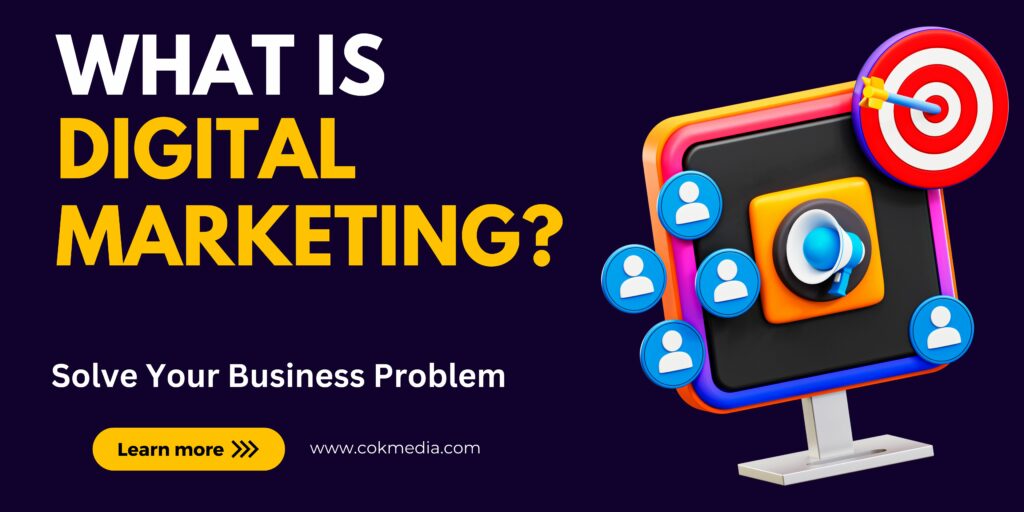Introduction
A well-crafted marketing strategy is the cornerstone of success in today’s fast-paced business world. Cok Media’s blog post will walk you through the complexities of developing an outstanding marketing strategy that not only expands your business but also establishes a strong presence in the ever-changing social media landscape. Let’s go on a marketing mastery journey, examining six key steps to developing a strategy that will propel your company to new heights. And will make you a successful businessman.
Business summary
A business summary, also known as a company summary or business overview, is a brief overview of the key aspects of a company. It usually contains information about the company’s mission, products or services, target market, competitive advantages, and a brief history. Here is the business summary and for more information our book is called Business Horse, you can read it absolutely free.
Business Name Summary
Mission Statement: Provide a clear and concise statement outlining the purpose and goals of your business.
Overview: Give a brief description of your company, including the industry in which it operates and the products or services it offers.
Founding Date: Include the date your company was founded.
Founders/Leaders: List key individuals involved in the business’s founding or leadership.
Specify your company’s location(s), whether it’s a physical address or an online presence.
Products/Services: Highlight the main products or services your business offers, emphasizing key features or unique selling points.
Free Consultation
Target Market: Determine your target audience’s demographics as well as any specific market segments you want to reach.
Describe what distinguishes your company from competitors, such as unique features, quality, pricing, or customer service.
Milestones/Achievements: Highlight any significant achievements, milestones, or recognitions that your company has received.
Financial Overview: Give a high-level overview of your company’s financial health, including revenue, profitability, and growth trends.
Future Plans: Briefly outline any future initiatives, expansions, or strategic goals.
Discuss the fundamental principles or values that guide your company’s decisions and operations.
Include relevant contact information, such as email addresses, phone numbers, or a link to your website.
Keep in mind that the content and level of detail in a business summary will differ depending on the audience and purpose. Whether for internal planning, external stakeholders, or potential investors, customize the business summary to effectively communicate the key aspects of your company.
Swot Analysis:
A SWOT analysis is a strategic planning tool that assists businesses in identifying and evaluating internal Strengths and Weaknesses as well as external Opportunities and Threats. It provides a comprehensive overview of the current state of the business and aids in the development of future success strategies. Here’s a template to help you create a SWOT analysis for your company:
SWOT Analysis: [Business Name]
Strengths:
1. Strong Brand Reputation:
– Highlight positive aspects of your brand reputation and recognition.
2. Skilled Workforce:
– Discuss the expertise and skills of your team.
3. Innovative Products/Services:
– List any unique or innovative offerings that set your business apart.
4. Effective Marketing Strategies:
– Discuss successful marketing campaigns and strategies.
5. Financial Stability:
– Highlight financial strengths, such as steady revenue or strong cash flow.
Weaknesses:
1. Limited Market Presence:
– Discuss any challenges in expanding your market reach.
2. Dependence on a Single Supplier:
– Address any vulnerabilities related to suppliers or dependencies.
3. Outdated Technology:
– Identify any technological gaps that may impact operations.
4. High Employee Turnover:
– Acknowledge challenges related to employee retention.
5. Limited Product Line:
– Discuss any gaps or limitations in your product or service offerings.
Opportunities:
1. Market Expansion:
– Identify potential new markets or customer segments.
2. Technological Advancements:
– Explore opportunities presented by emerging technologies.
3. Marketing Strategy Partnerships:
– Highlight the potential for collaborations or partnerships.
4. Growing Demand for Sustainable Products:
– Discuss how trends toward sustainability may benefit your business.
5. Economic Recovery:
– Explore opportunities arising from improving economic conditions.
Threats:
1. Intense Competition:
– Acknowledge competitive challenges and market saturation.
2. Economic Downturn:
– Consider potential negative impacts on consumer spending.
3. Changing Regulatory Environment:
– Address potential challenges arising from regulatory changes.
4. Rapid Technological Changes:
Discuss how rapid tech advancements may pose threats.
5. Supply Chain Disruptions:
– Identify potential risks related to supply chain vulnerabilities.
This SWOT analysis template is a good place to start. It should be adjusted and customized to your specific business context and industry. Revisit and update your SWOT analysis on a regular basis to ensure it remains relevant as your business grows Top of Form
Our Services
5 Marketing Facts
Here are some key marketing facts to help you understand the current marketing landscape:
- The importance of content cannot be overstated:
Content marketing generates three times the number of leads as traditional outbound marketing, highlighting the significance of valuable and relevant content.
2. Dominance in Video:
Customers prefer to learn about a product or service through video, with 72% preferring to do so.
3. Mobile Optimization Is Important:
Mobile devices account for more than half of all internet traffic, emphasizing the importance of mobile-friendly marketing strategies.
4. Influence on social media:
With over 3.6 billion users worldwide, social media plays an important role. Businesses use social media platforms such as Facebook, Instagram, and Twitter to increase brand awareness and engagement.
5. Email Marketing Return on Investment:
Email marketing is still a powerful tool, with a $42 return on investment (ROI) for every dollar spent.
1. Understanding Your Business and Market.
Begin by conducting a thorough analysis of your company and its market position. Discuss the significance of SWOT analysis, market research, and competitor analysis in developing a thorough understanding of your company’s environment. Show how a thorough understanding of your company’s strengths, weaknesses, opportunities, and threats serves as the foundation for a successful marketing strategy.
2. Defining Your Target Audience
Investigate the importance of identifying and defining your target audience. Discuss the role of buyer personas in developing a targeted and personalized marketing strategy. To effectively tailor your marketing messages, emphasize the importance of understanding your audience’s needs, preferences, and behaviors.
3. Establishing Clear Marketing Objectives
Examine the process of developing SMART (Specific, Measurable, Achievable, Relevant, and Time-bound) marketing goals. Discuss how well-defined objectives can act as a road map for your marketing efforts, guiding them and providing a measurable framework for success.
4. Crafting a Marketing Strategy Mix
Examine the components of the marketing mix, including the 4Ps (Product, Price, Place, and Promotion). Discuss how important it is to align these elements cohesively in order to create a compelling value proposition. Investigate how an effective marketing mix meets customer needs and improves the overall customer experience.
5. Leveraging the Power of Social Media
Investigate the role of social media in contemporary marketing. Discuss the various platforms available and how to use them strategically for brand building, engagement, and lead generation. Investigate the importance of content marketing, influencer partnerships, and community building in establishing a strong social media presence.
6. Implementing and Monitoring Your Plan
Take readers through the marketing plan’s implementation phase. Discuss the significance of a phased approach, effective communication, and adaptability to market dynamics. In order to monitor the success of the marketing plan and make data-driven adjustments, emphasize the role of analytics and key performance indicators (KPIs).
Conclusion
To summarize, developing an outstanding marketing plan necessitates a comprehensive approach that incorporates a thorough understanding of your business, a strategic mindset, and a keen awareness of the evolving social media landscape. Following the six key steps outlined in this guide will equip you to navigate the complexities of modern marketing, propelling your company to unprecedented success. Remember that marketing excellence is a never-ending journey of adaptation, innovation, and a relentless commitment to providing value to your audience. Allow this guide to serve as your compass as you embark on your journey to marketing mastery.
Frequently Ask And Question ( FAQ )
Marketing is a broad concept that encompasses a variety of activities, processes, and strategies aimed at developing, communicating, delivering, and exchanging offerings of value to customers, clients, partners, and society as a whole. The primary goal of marketing is to meet the needs and desires of a target audience while also achieving the organization’s objectives. Here are some key marketing components and concepts:
- Understanding the Needs of the Customer:
Understanding customer needs and desires is at the heart of marketing. This entails conducting market research to identify target audiences, their preferences, and purchasing habits.
2.Adding Value:
Marketing is concerned with providing value to customers. This entails creating products or services that meet a need, provide unique features, or solve problems.
3. Product Creation and Innovation:
Marketing is important in the development and evolution of products and services. This includes developing products that meet market demands and introducing innovations that distinguish the offerings.
4. Segmentation of the market:
Marketers frequently segment the market based on demographics, psychographics, behavior, or other criteria. This enables more targeted and efficient marketing strategies.
5. Building a Brand:
Creating and managing a brand is an important aspect of marketing. A strong brand instills trust and loyalty in customers, influencing their perceptions and decisions.
6. Communication and promotion:
Promotion entails communicating value to customers. Advertising, public relations, social media marketing, content marketing, and other channels to raise awareness and persuade customers are all included.
7. Pricing Methodologies:
Choosing the appropriate price for a product or service is an important marketing decision. Costs, competitor pricing, and perceived value are all factors that pricing strategies consider.
8. Channels of Distribution:
Marketing decisions affect how products are made available to customers. This includes distribution channel, logistics, and supply chain management options.
9.Consumer Attitudes:
Understanding consumer behavior is essential for successful marketing. This entails investigating how individuals or groups make decisions, what influences their decisions, and how they react to marketing efforts.
10. Marketing Relationships:
Long-term customer relationships are an important marketing concept. This includes ongoing communication, customer support, and efforts to keep customers satisfied and loyal.
11. Ethics and Social Responsibility:
Marketing also takes into account a company’s ethical and social responsibilities. Fairness, transparency, and respect for consumers and stakeholders are all hallmarks of ethical marketing practices.
12. Orientation to the Market:
A market-oriented approach, in which businesses are responsive to customer needs and market dynamics, is often characterized by successful marketing.
The four marketing fundamentals, also known as the “Four Ps,” are a foundational framework that businesses use to develop and implement marketing strategies. These are the key components of a marketing mix, each of which plays an important role in the overall marketing strategy. The four Ps are as follows:
- Product:
This refers to the actual goods or services that a business offers to meet the needs and wants of its target market. It involves decisions about product design, features, quality, branding, packaging, and any additional services associated with the product.
2. Price:
Pricing is a strategic decision that involves determining the value of the product or service in the eyes of the customer. Pricing strategies take into account factors such as production costs, competitor pricing, perceived value, and market demand. The goal is to set a price that aligns with the value proposition and market positioning.
3. Location (Distribution):
The distribution channels and methods used to make the product or service available to the target audience are referred to as place. This includes deciding where and how customers can get the product, taking into account factors like retail locations, online platforms, direct sales, and logistics.
4. Promotion:
The communication and promotion of a product or service to the target market is referred to as promotion. Advertising, public relations, sales promotion, personal selling, and other promotional activities are all included. The goal is to raise awareness, generate interest, and persuade customers to buy.
In the 1960s, marketer E. Jerome McCarthy introduced and Philip Kotler popularized the Four Ps framework. It offers businesses a structured approach for developing comprehensive marketing strategies. However, as marketing has evolved and consumer behavior has changed, additional Ps such as People, Processes, and Physical Evidence have been proposed to further enhance the marketing mix. Nonetheless, the original Four Ps remain a fundamental and widely used marketing planning and execution model.
Marketing is a strategic and multifaceted discipline in business that focuses on creating, communicating, and delivering value to customers. It entails understanding customer needs, developing products or services to meet those needs, and effectively marketing them to target audiences. Product development, pricing strategies, distribution channels, and promotional activities such as advertising and public relations are all part of marketing. Successful marketing creates and manages powerful brands.cultivates customer relationships, and adapts to market trends through continuous analysis and innovation. Ethical considerations are also important, with an emphasis on transparency and honesty to foster consumer trust. Finally, marketing is critical to achieving business objectives by connecting products or services with the right audience and influencing brand perception and customer loyalty.
- Create Interesting Content:
Create high-quality, relevant content that speaks to your target audience. Blog posts, videos, infographics, and social media updates are all examples of this. To attract and engage potential customers, share valuable insights, solve problems, and showcase your expertise.
2. Improve Your Online Presence:
Make sure your company has a strong online presence. This includes search engine optimization (SEO), creating engaging social media profiles, and utilizing online review platforms. A strong online presence boosts visibility and credibility.
3. Use Social Media Advertising:
Spend money on targeted social media advertising to reach out to specific demographics. Platforms such as Facebook, Instagram, and LinkedIn provide powerful advertising tools for promoting your products or services to a specific audience. To attract attention, create visually appealing ad creatives and compelling copy.
4. Execute Email Marketing Campaigns:
Create and nurture an email list of prospective and current customers. Utilize email marketing campaigns to distribute promotions, product updates, and useful content. Personalize your messages and use segmentation to effectively target different customer groups.
5. Participate in Local Marketing Initiatives:
To connect with your community, prioritize local marketing efforts. Participating in local events, collaborating with other businesses, and supporting community causes are all examples of this. To improve your visibility in local search results, use local search engine optimization (SEO) strategies.
Remember that consistency and adaptability are the keys to successful marketing. Assess the performance of your marketing strategies on a regular basis, listen to customer feedback, and be willing to change your approach to meet the changing needs of your audience and the market.











